Welcome to our free classical music site

Do you write about classical music? Are you a blogger? Want to team up with Classical Connect? Send us a message, let's talk!

Do you write about classical music? Are you a blogger? Want to team up with Classical Connect? Send us a message, let's talk!
April 20, 2015. Sergey Prokofiev. Here at Classical Connect we love all music, from the Renaissance to the contemporary. Of course we cannot get enough of the core, from Bach to the Viennese masters, to the Romantics of the 19th century, and then, through Mahler into the 20th and on. But life would be boring without the great experiments of the early composers, who were trying to find their way from craft to art. Or the more obscure baroque musicians who developed the unheard-of-before styles, such as, for example, opera. And of course we value the music of the late 20th century, as challenging as it sometimes is. And within this enormous aural universe, we have our favorites. Some of them stay with us for a very long time, other retire to the background. The same of course happens with musical tastes in general: just take a look at the Klavierabend (piano recital) programs of the first half of the 20th century: they are drastically different from what you would hear today. One composer that remains our perennial favorite is Sergei Prokofiev. As is the case with so many talented Russian artists whose life spanned two different eras, one before, another after the October Revolution, his life was full of tragedies and triumphs, exiles and returns. We’ve written about Prokofiev, who was born on April 23rd of 1891, many times, for example, here last year, and here the year before. That’s why this time we’ll just play one piano sonata, no. 8. This is the third of the so-called War sonatas; this is a traditional misnomer as the first of the three, Piano Sonata no. 6, was completed in February and premiered in April of 1940, before the Soviet Union was invaded by the Germans. Sviatoslav Richter was the pianist to first play sonatas no. 6 and 7. Sonata no. 8, on the other hand, was premiered by Emil Gilels; the event took place on December 30th of 1944 in the Great Hall of Moscow Conservatory.
Romantics of the 19th century, and then, through Mahler into the 20th and on. But life would be boring without the great experiments of the early composers, who were trying to find their way from craft to art. Or the more obscure baroque musicians who developed the unheard-of-before styles, such as, for example, opera. And of course we value the music of the late 20th century, as challenging as it sometimes is. And within this enormous aural universe, we have our favorites. Some of them stay with us for a very long time, other retire to the background. The same of course happens with musical tastes in general: just take a look at the Klavierabend (piano recital) programs of the first half of the 20th century: they are drastically different from what you would hear today. One composer that remains our perennial favorite is Sergei Prokofiev. As is the case with so many talented Russian artists whose life spanned two different eras, one before, another after the October Revolution, his life was full of tragedies and triumphs, exiles and returns. We’ve written about Prokofiev, who was born on April 23rd of 1891, many times, for example, here last year, and here the year before. That’s why this time we’ll just play one piano sonata, no. 8. This is the third of the so-called War sonatas; this is a traditional misnomer as the first of the three, Piano Sonata no. 6, was completed in February and premiered in April of 1940, before the Soviet Union was invaded by the Germans. Sviatoslav Richter was the pianist to first play sonatas no. 6 and 7. Sonata no. 8, on the other hand, was premiered by Emil Gilels; the event took place on December 30th of 1944 in the Great Hall of Moscow Conservatory.
Prokofiev started writing the sonata much earlier, in 1939. That was the year when he met and fell in love with Mira Mendelson, a young writer half his age. At the time Prokofiev was still married to Lina Llubera (they married in 1923), a Spanish singer whom he met in New York and brought to Moscow in 1936 when he decided to return to the Soviet Union. By 1941 Prokofiev and Lina were separated, and he was living openly with Mira. Mira became Prokofiev’s wife in 1948 and a very troubling story ensued (we’ll write about it another time). Mira is the dedicatee of the Eighth sonata, probably the most complex and deep of the three. Gilels’s 1944 performance was a triumph and soon became an essential part of his vast repertoire. He recoded it a number of times and played it, very successfully, around the world (Richter also made a great recording of the sonata). Here’s a studio recording, made by Gilels in Vienna in 1974. It’s four minutes longer than, for example, his live concert recording of 1967.
Permalink
April 13, 2015. Rebel and de Wert. This week, just like the previous one, looks rather bare: only one composer of note was born during this period, and even he was much more popular during his lifetime than he is today. His name is Jean-Féry Rebel, and he was born in Paris on April 18th, 1666 (that makes him two years older than François Couperin). His father was a singer at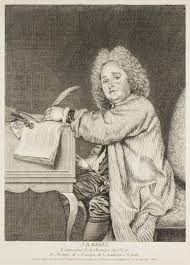 the King’s chapel (the King being Louis XIV), and apparently Jean-Féry began studying music at an early age. He was noticed by Jean-Baptiste Lully, then the most famous composer in France, and became his pupil. In 1705 Rebel was made one of the 24 musicians in Violons du Roi orchestra, and some years later – the Chamber composer, a very prestigious position. His only opera, Télémaque, was not successful; on the other hand, his dance music was extremely popular with the court. This is not surprising, considering how much Louis XIV liked to dance himself and later in his life, to watch ballet. But Rebel was a serious and innovative composer; in 1737 he wrote a ballet called Les elemens, which he preceded by a short section called Le Cahos (Chaos). You can listen to it and imagine how startled the listeners would’ve been (in this recording Musica Antiqua Köln is conducted by Reinhard Goebel). And here is Rebel’s earlier piece, Le tombeau de M. Lully, written as a tribute to his teacher. It’s performed by the violinist Amandine Beyer and the ensemble L'Assemblée des Honnestes Curieux.
the King’s chapel (the King being Louis XIV), and apparently Jean-Féry began studying music at an early age. He was noticed by Jean-Baptiste Lully, then the most famous composer in France, and became his pupil. In 1705 Rebel was made one of the 24 musicians in Violons du Roi orchestra, and some years later – the Chamber composer, a very prestigious position. His only opera, Télémaque, was not successful; on the other hand, his dance music was extremely popular with the court. This is not surprising, considering how much Louis XIV liked to dance himself and later in his life, to watch ballet. But Rebel was a serious and innovative composer; in 1737 he wrote a ballet called Les elemens, which he preceded by a short section called Le Cahos (Chaos). You can listen to it and imagine how startled the listeners would’ve been (in this recording Musica Antiqua Köln is conducted by Reinhard Goebel). And here is Rebel’s earlier piece, Le tombeau de M. Lully, written as a tribute to his teacher. It’s performed by the violinist Amandine Beyer and the ensemble L'Assemblée des Honnestes Curieux.
Giaches de Wert is one of many Renaissance composers whose date of birth was either unrecorded or lost. We’ve never written about him before, and this week is as good as any to rectify this omission. Giaches, whose first name was spelled in many ways, including the frenchified Jacques, was born around 1535 somewhere in Flanders (his name suggests that he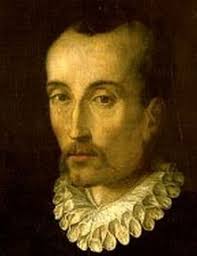 may have been born in Weert, not far from Antwerp). One of the many Flemish composers who spent most of their productive years in Italy, he belonged to the same generation as Palestrina, Orlando di Lasso and Andrea Gabrieli. Most of his life de Wert was associated with two very powerful (and related) Italian families: d’Este and Gonzagas. As a youngster he sung at the chapel of Maria di Cardona, wife of Francesco d’Este (Francesco was a son of Lucrezia Borgia from her third marriage to Alfonso d’Este, Duke of Ferrara). In 1550 Wert moved to the town of Novellara, when he washired as a musician for a branch of the Gonzaga family; he would live there for the following 15 years. Mantua was the main seat of the Gonzagas, while d’Este ruled in Ferrara; Wert traveled to both cities. (Just six years earlier, Ferrante Gonzaga had brought a 12 years old Orlando di Lasso to Mantua; some year later, Frescobaldi and Monteverdi would work there for the Gonzagas. Ferrara, at least as much a musical center as Mantua, hosted Orlando, Frescobaldi and Gesualdo, among many others). In 1565 Wert was appointed the Maestro di Capella of the newly built ducal chapel of Santa Barbara in Mantua and moved there from Novellara. He got married (according to some sources, to one Lucrezia of a minor branch of Gonzaga,) but his wife cuckolded him with Bonvicino, a composer and Wert’s rival; when the affair became public, Lucrezia was expelled from Mantua. Wert stayed behind, his reputation compromised. Wert had his own share of scandals: he started an affair in Ferrara with one Tarquinia Molza, an accomplished musician of noble descent and a lady-in-waiting to the Duchess of Ferrara. That was considered inappropriate and when the Duke Alfonso d’Este learned about the affair, Tarquinia was banished from the court.
may have been born in Weert, not far from Antwerp). One of the many Flemish composers who spent most of their productive years in Italy, he belonged to the same generation as Palestrina, Orlando di Lasso and Andrea Gabrieli. Most of his life de Wert was associated with two very powerful (and related) Italian families: d’Este and Gonzagas. As a youngster he sung at the chapel of Maria di Cardona, wife of Francesco d’Este (Francesco was a son of Lucrezia Borgia from her third marriage to Alfonso d’Este, Duke of Ferrara). In 1550 Wert moved to the town of Novellara, when he washired as a musician for a branch of the Gonzaga family; he would live there for the following 15 years. Mantua was the main seat of the Gonzagas, while d’Este ruled in Ferrara; Wert traveled to both cities. (Just six years earlier, Ferrante Gonzaga had brought a 12 years old Orlando di Lasso to Mantua; some year later, Frescobaldi and Monteverdi would work there for the Gonzagas. Ferrara, at least as much a musical center as Mantua, hosted Orlando, Frescobaldi and Gesualdo, among many others). In 1565 Wert was appointed the Maestro di Capella of the newly built ducal chapel of Santa Barbara in Mantua and moved there from Novellara. He got married (according to some sources, to one Lucrezia of a minor branch of Gonzaga,) but his wife cuckolded him with Bonvicino, a composer and Wert’s rival; when the affair became public, Lucrezia was expelled from Mantua. Wert stayed behind, his reputation compromised. Wert had his own share of scandals: he started an affair in Ferrara with one Tarquinia Molza, an accomplished musician of noble descent and a lady-in-waiting to the Duchess of Ferrara. That was considered inappropriate and when the Duke Alfonso d’Este learned about the affair, Tarquinia was banished from the court.
All along Wert was composing, mostly secular music. He wrote about 230 madrigals, many of them on the verses by famous poets, Bembo, Petrarca, Ludovico Ariosto, and especially his contemporary, Torquato Tasso. We’ll hear two of his madrigals, Ah dolente partite (here) and Io non son però morto (here). The first one is performed by the ensemble La Venexiana, the second, by the Quink Vocal Quintet. Also, one piece of sacred music by Giaches de Wert: his sublime motet Vox in Rama. Ensemble Currende is directed by Erik van Nevel.
PermalinkApril 6, 2015. Schumann’s Frauenliebe. As far as composers’ birthdays go, several previous weeks were brimming with major talent but this one is pretty meager: Giuseppe Tartini of Devil’s Trill fame being the most interesting of the bunch. So we’ll use it to publish a little essay Joe DuBose wrote about Robert Schumann’s song cycle Frauenliebe und –leben. To illustrate it, we’ll use the recording made by the great British contralto Kathleen Ferrier in 1950. Ferrier, the favorite singer of Bruno Walter and Benjamin Britten, died of breast cancer in 1953, just 41 year old. Fortunately, she left a number of recordings treasured by music lovers ever since. John Newmark is at the piano. ♫
The year 1840 saw at least 138 songs flow from the pen of Robert Schumann, which has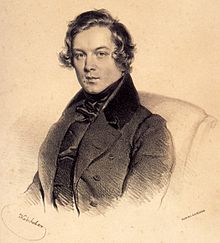 since become known as his Liederjahr, or “Year of Song.” Until that year, Schumann had composed virtually exclusively for the piano. Yet, neither the sudden shift to vocal music, nor the abundance of this creative outpouring, was purely coincidental. It marked the culmination of his courtship of Clara Wieck, and their long-awaited and hard-won marriage.
since become known as his Liederjahr, or “Year of Song.” Until that year, Schumann had composed virtually exclusively for the piano. Yet, neither the sudden shift to vocal music, nor the abundance of this creative outpouring, was purely coincidental. It marked the culmination of his courtship of Clara Wieck, and their long-awaited and hard-won marriage.
Schumann first met Clara in March 1828, when both were invited to a musical evening in the home of Dr. Ernst Carus. Impressed with Clara’s skill at the piano, Schumann soon after began taking piano lessons from Clara’s father, Friedrich, during which time he lived in the Wieck’s household. Schumann and Clara quickly formed a close bond that would eventually blossom into a romantic, though clandestine, relationship. In 1837, on her 18th birthday, Schumann proposed, and Clara accepted. Friedrich, however, who had a rather unfavorable opinion of Schumann, refused to give the composer his permission to marry his daughter. The long courtship and Friedrich’s refusal was a great strain on the relationship. Clara and Schumann exchanged love letters, and were forced to meet in secret. Schumann would even wait for hours in a café just to catch a brief glimpse of Clara as she left one of her concerts. The couple sued Friedrich, and after a lengthy court battle, Clara was finally allowed to marry Schumann without her father’s consent. The wedding took place in 1840.
Frauenliebe und -leben (A Woman’s Love and Life) was one of the song cycles, along with the Liederkreis of Eichendorff and Heine’s Dichterliebe, composed during the intense creative episode surrounding Schumann’s marriage to Clara. The cycle of poems, written by the German poet and botanist Adelbert von Chamisso in 1830, describes events in the life of a woman—from her first meeting with her future husband, to their marriage, the birth of their child, and his seemingly untimely death. Adelbert’s cycle consists of nine poems. However, Schumann set only eight, omitting the poem, Traum der eignen Tage. His setting displays a departure from the Schubertian Lied, with the piano taking on an increasingly independent and important role in portraying the essence and mood of the text. Schumann’s sense of unity is also evident in the reprise of music from the first song as a postlude that concludes the last. While Schumann’s is the best known, two other notable settings of Adelbert’s cycle were composed by Carl Lowe and Franz Paul Lachner. (Continue)Permalink
March 30 2015. Cabezón, Haydn, Rachmaninov and Stradella. This is another week that brings together, even if fleetingly and tenuously, several major composers from very different eras. The oldest in this group is Antonio de Cabezon, one of the most important keyboard composers of the Spanish Renaissance. Cabezón was born on March 30th of 1510, which makes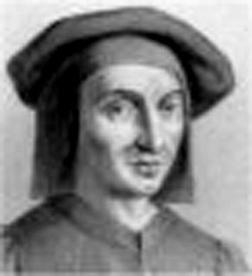 him five years younger than Cristóbal de Morales and one generation older than Tomás Luis de Victoria, two greatest composers of the Spanish Renaissance. Little is known about Cabezón: he was born in a small town in northern Spain not far from Burgos, and was blind from childhood. In 1526 he entered the service of Queen Isabella, wife of Charles I, king of Spain, as an organist and clavichord player. In 1538 he was appointed the chamber musician to Charles himself, who, as Charles V was the ruler of the Holy Roman Empire and the most powerful monarch in all of Europe. Later on Cabezón was appointed the music teacher to Prince Felipe, the future king of Spain, and accompanied him on his travels to Italy, the Netherlands, Germany and London. Cabezón’s music influenced many composers, especially the English ones, such as Thomas Tallis and William Byrd. Here’s is a short piece by Cabezón called La dama le demanda, from his Works of keyboard music, harp and vihuela. Fahmi Alqhai plays viola da gamba, Alberto Martínez Molina is on the organ.
him five years younger than Cristóbal de Morales and one generation older than Tomás Luis de Victoria, two greatest composers of the Spanish Renaissance. Little is known about Cabezón: he was born in a small town in northern Spain not far from Burgos, and was blind from childhood. In 1526 he entered the service of Queen Isabella, wife of Charles I, king of Spain, as an organist and clavichord player. In 1538 he was appointed the chamber musician to Charles himself, who, as Charles V was the ruler of the Holy Roman Empire and the most powerful monarch in all of Europe. Later on Cabezón was appointed the music teacher to Prince Felipe, the future king of Spain, and accompanied him on his travels to Italy, the Netherlands, Germany and London. Cabezón’s music influenced many composers, especially the English ones, such as Thomas Tallis and William Byrd. Here’s is a short piece by Cabezón called La dama le demanda, from his Works of keyboard music, harp and vihuela. Fahmi Alqhai plays viola da gamba, Alberto Martínez Molina is on the organ.
Alessandro Stradella belonged to the next period, the Baroque. He had quite an amazing life, full of mayhem and intrigue; of the composers of the time, only Carlo Gesualdo might have had a more adventurous life. Stradella was born on April 3rd of 1639 into an aristocratic Tuscan family. During his short life (he was stabbed to death at the age of 42 in a plaza right in the middle of Genoa) he managed to create more than 300 works. Here’s his Cantata per il santissimo natale, Schola Cantorum Basiliensis is conducted by August Wenzinger.
Franz Joseph Haydn, born on March 31st of 1732, was one of the greatest, if sometimes underappreciated, composers ever. We’ve written about him many times, and will write more. Haydn was extremely prolific, writing in every musical genre known in his time. He composed 104 symphonies, more than 60 quartets, trio, concertos, wonderful cantatas and even operas. He also wrote 62 piano sonatas. On the surface most of them are deceptively simple, but in reality they are highly sophisticated and carry a tremendous amount of material. Some of them are as good as Mozart’s, if not better, and would not be surpassed till Beethoven’s mature years. Murray Perahia, the American pianist of a great range and talent, has recently embarked on a tour playing a program that includes Haydn’s Sonata in A-flat Major, Hob. XVI: 46. Perahia’s interpretation is immensely satisfying on all levels: technically flawless, it is musically probing, the sound is beautiful but without any exaggerations, the tempos are nimble and move the sonata along its way. It’s probably one of the best interpretations we’ve heard in ages. Unfortunately, there are no publicly available Perahia recordings of this sonata, so in its stead, we have one made by the Croatian pianist Ivo Pogorelich early in his uneven career, here. Different and highly idiosyncratic, it’s still very interesting in its own right.
The great Russian composer and pianist Sergei Rachmaninov was born on April 1st of 1873. We’ve written about him before, so today we’ll combine his commemoration with the recent 100th anniversary of Sviatoslav Richter. We’ll hear several preludes, recorded live during the concert he gave in Manchester in 1969: op. 32 no. 10, op.23 no.4 and op.23 no.5.
PermalinkMarch 23, 2015. Pierre Boulez. On March 26th we’ll celebrate the 90th birthday of Pierre Boulez, one of the most distinguished musical figures of the 20th century, a composer, conductor, writer, music entrepreneur and organizer, lecturer, professor – in short, a veritable one-man cultural phenomenon. It’s difficult to overestimate his influence on the development of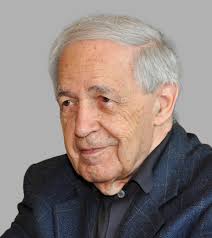 classical music during the last 70 years. Boulez was born in 1925 in a small town of Montbrison in central France. As a boy he was equally interested in music and mathematics. He took courses in higher math in Lyon (his father, an industrialist, wanted Pierre to become an engineer) but a year later moved to the German-occupied Paris and, instead of going to Ecole Polytechnique, entered the Conservatory. His teacher in the harmony class was Olivier Messiaen, who helped Boulez to discover the new world of 12-tone music. Boulez’s first compositions, like Douze notations, which he wrote at the age of 20, were very much in the style of Anton Webern, though in the following years he developed a distinct, personal style. Boulez’s large Second piano sonata (1948) made him known internationally; one of the champions of Boulez’s music was the pianist Yvonne Loriod, the second wife of Messiaen; she premiered the Second Sonata in Darmstadt, Germany. After the war, the New Music Summer School in Darmstadt was a major center for innovative music. Boulez taught there, and that’s where he met his peers: Luciano Berio, Karlheinz Stockhausen, John Cage, György Ligeti and many other leading modernists. With all this talent, Darmstadt served as an incubator for a new music style. Some of the ideas that influenced this style were not esthetic but rather ideological; in the aftermath of the war, young composers abhorred all “romantic,” nationalist aspects of music that could be co-opted by the state, as the Nazis did with Wagner and Beethoven. Instead, they developed a non-ideological, detached but not un-emotional, method called serialism, which expanded on the twelve-tone system created by Schoenberg and his pupils in Vienna some decades earlier. A major serialist work by Boulez was Structures, Book I, written in 1952. In 1961 he rewrote some of the material of the composition, creating Book II. Another idea that could be traced to Darmstadt of the early 1950s was aleatoric, or chance music. Boulez wrote several aleatoric pieces in the 60s and the 70s, one of them – Rituel in memoriam Bruno Maderna composed in memory of his friend, the Italian composer Bruno Maderna, also a regular visitor to Darmstadt, who died there at the age of 53 while rehearsing his opera, Satyricon.
classical music during the last 70 years. Boulez was born in 1925 in a small town of Montbrison in central France. As a boy he was equally interested in music and mathematics. He took courses in higher math in Lyon (his father, an industrialist, wanted Pierre to become an engineer) but a year later moved to the German-occupied Paris and, instead of going to Ecole Polytechnique, entered the Conservatory. His teacher in the harmony class was Olivier Messiaen, who helped Boulez to discover the new world of 12-tone music. Boulez’s first compositions, like Douze notations, which he wrote at the age of 20, were very much in the style of Anton Webern, though in the following years he developed a distinct, personal style. Boulez’s large Second piano sonata (1948) made him known internationally; one of the champions of Boulez’s music was the pianist Yvonne Loriod, the second wife of Messiaen; she premiered the Second Sonata in Darmstadt, Germany. After the war, the New Music Summer School in Darmstadt was a major center for innovative music. Boulez taught there, and that’s where he met his peers: Luciano Berio, Karlheinz Stockhausen, John Cage, György Ligeti and many other leading modernists. With all this talent, Darmstadt served as an incubator for a new music style. Some of the ideas that influenced this style were not esthetic but rather ideological; in the aftermath of the war, young composers abhorred all “romantic,” nationalist aspects of music that could be co-opted by the state, as the Nazis did with Wagner and Beethoven. Instead, they developed a non-ideological, detached but not un-emotional, method called serialism, which expanded on the twelve-tone system created by Schoenberg and his pupils in Vienna some decades earlier. A major serialist work by Boulez was Structures, Book I, written in 1952. In 1961 he rewrote some of the material of the composition, creating Book II. Another idea that could be traced to Darmstadt of the early 1950s was aleatoric, or chance music. Boulez wrote several aleatoric pieces in the 60s and the 70s, one of them – Rituel in memoriam Bruno Maderna composed in memory of his friend, the Italian composer Bruno Maderna, also a regular visitor to Darmstadt, who died there at the age of 53 while rehearsing his opera, Satyricon.
In 1970, uponsuggestion by George Pompidou, the President of France, Boulez created IRCAM (Institut de Recherche et Coordination Acoustique/Musique), a major institution dedicated to research in electro-acoustical and modern music. Later, Boulez founded Ensemble InterContemporain, which is associated with IRCAM. The ensemble is a foremost advocate of modernist music.
Boulez started conducting in the late 1950s. Even though he never had formal training, he developed into one of the major conductors of the late-20th century. He served as the music director of the New York Philharmonic, the chief conductor of the BBC Symphony, the Principal Guest Conductor of the Chicago Symphony; he conducted all major orchestras of Europe and the US. He’s especially well known for his interpretation of modernist composers; at the same time, he’s one of the foremost Mahlerians of our days. He also conducted practically all of Wagner’s operas at Bayreuth, both of Berg’s operas – Wozzeck was one of his early triumphs, and Lulu, and many other operas.
Boulez’s music is often difficult, so we’ll confine ourselves to just two pieces, one for the piano, another – orchestral. Here’s Multiple (1965) from Boulez’s “project” Eclat/Multiple (he revised the original pieces several times). The composer conducts Ensemble InterContemporain. And here’s Chapter I of Book II of Structures. Pierre-Laurent Aimard and Florent Boffard are playing two pianos.Permalink
March 20, 2015. Today is 100th anniversary of Sviatoslav Richter, one of the greatest pianists of the 20th century.